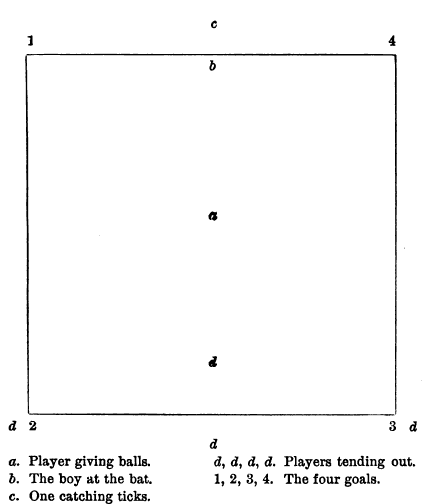Round-ball, Massachusetts, 1840's
From the novel Lem, a New England Village Boy: His Adventures and His Mishaps, by Noah Brooks. New York: Charles Scribner's Sons (1901). Noah Brooks was born in Maine in 1830, and so presumably would likely have played roundball in the 1840s.
The word “field” must not mislead any boy into thinking that the ball-ground of those days was anything like the field that came into use when the game of base-ball was invented, or gradually grew out of the game of sixty years ago. Even the titles of the players were not like those of the base-ball field. The boy who threw the ball to him at the bat was said to be giving balls; the boy at the bat was called the striker; the catcher behind him was said to be catching ticks, and the players who stood outside to catch and hurl in the ball were tending out. The bases, as they were afterward called, were four in number, and were called "gools," a word which probably came from "goals," meaning marks or points to be reached in a race. These four goals were set in the form of a square, and as soon as the boy at the bat had hit the ball and sent it anywhere, either before or behind him, he started for the first goal, which was only a few feet to his right, as he stood at the batsman's place. He ran to the other three goals as soon as he saw a chance to get there without being hit; for if one of the boys of the other side should throw the ball and hit him, he was "out"; and with him the whole of his side went out and the other side came in. This made the inning very short, and the chances for any side keeping in long were not good.
The ball-ground, which was on the Common, was laid off something like the diagram on the opposite page.
The only way for a side of players to be put out, was for one of their number to be hit with the ball while off his goal. The only “foul” there was in the game was when the ball went over a fence; then every boy who was not “in” yelled at the top of his voice, “Over the fence is out!” and out went the unlucky batsman and his side with him. If the ball, after being struck by the boy at the bat, was caught by any one of the other side, the ins went out; and if it struck the ground once before being caught by the player, the ins went out all the same, for that was called “the first ground hop”; but if it struck the ground twice before it bounced into the adversary's hands, that did not count; it was a “second ground hop”, and that was reckoned “no good” for the out side. If the ball struck the bat and made a tick loud enough to be heard by those near by, and was then caught by the boy who was “catching ticks”, the ins were out; for that is what they were chiefly looking after.
Choosing sides was usually a very delicate piece of business; for all boys generally divide up into clans, or parties, and it was needful that the two boys who headed the opposing sides should know exactly where each boy belonged in the division of the clans. The bat being thrown up in the air, it was caught as it came down by one of the players, and the other clasped his hand around the bat, and then the other leader placed his directly above it, and then number one shifted his hand next above that of number two, and so on, until the upper end of that bat was reached. If a short bit was left at the top of the bat, and he whose turn it was to shift up his hand could take hold of the bat by that little end with his fingers and sling it three times around his head, he was entitled to first choice of the boys to play in the game. The choice of sides then went on without delay, and the least skilful of the players went to tend out, four or five being allowed to each side when there were players enough to give each that number.
